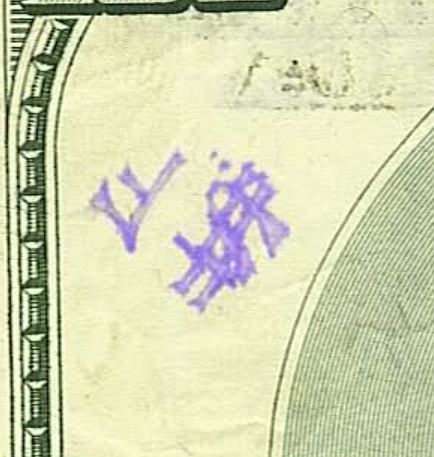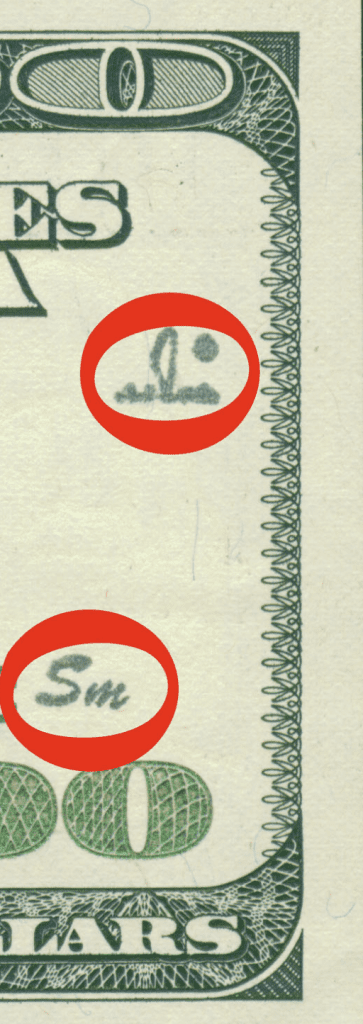Ever Noticed Strange Stamps on a Dollar Bill? Here’s What They Mean
You’re standing in line, about to pay for your coffee, when you notice something odd on your $20 bill—maybe a tiny red star, a pair of initials, or even a weird little bird symbol. It’s not part of the official design, but it’s clearly been stamped there on purpose. What gives?
Welcome to the fascinating world of chop marks—tiny stamps with big stories. These little symbols have traveled far and wide, and if you’re holding a dollar bill with one, you’re holding more than just currency. You’re holding history.

What Exactly Are Chop Marks?
In the simplest terms, chop marks are small stamps added to U.S. currency by money changers or currency verifiers—mostly outside the United States. They’re used to confirm that a bill is real. Think of them like the passport stamps of the financial world: each mark signals that someone, somewhere, checked the bill and approved it.
These stamps are especially common in regions where counterfeit money is a real concern—places like Southeast Asia, parts of Africa, and Latin America. In areas where trust in central authorities or banking infrastructure might be shaky, chop marks help create a local system of credibility.
Video: The Reason Dollar Bills Have Letters 🤨 (EXPLAINED)
The History of Chop Marks: From Silver Coins to Paper Dollars
The word “chop” actually comes from Chinese merchants who used to stamp silver coins to show authenticity. In bustling markets, thousands of traders competed by marking coins with their own personal “chop.” It wasn’t about decoration—it was about trust.
Fast forward to modern times, and that practice naturally extended to paper currency. With the U.S. dollar being one of the most widely circulated currencies worldwide, it’s become a common target for chop marks. It’s like paper money got adopted into an ancient tradition of stamped verification.

Why Are U.S. Dollars Marked Abroad?
In economies where counterfeit bills are a major issue, money changers, traders, and local verifiers use chop marks as part of their due diligence. After confirming a dollar bill is legitimate—using watermarks, color-shifting ink, and all the usual tests—they’ll sometimes add their own mark to say, “I’ve checked this. It’s good.”
Here’s what that process usually accomplishes:
- Verification: It’s a sign that the bill has already passed security checks.
- Tracking: It helps local traders and financial institutions trace the flow of money.
- Trust-building: In places with less robust banking systems, a chop mark is like an unofficial seal of approval.

What Do Chop Marks Look Like?
They’re usually subtle—small enough not to block any important features of the bill. You might see:
- Tiny arrows or stars
- Birds or bows
- Stylized initials or letters
- Ink colors like blue, red, or black
One recently spotted $20 bill featured a neat bow and arrow stamp. These aren’t just random doodles—they’re deliberate, symbolic, and often regional. Some even look like miniature logos.
Video: Dollar Bill Secrets
Are Chop Marks Legal on U.S. Currency?
Let’s clear this up: Yes, chop marks are legal—sort of.
U.S. federal law prohibits defacing or mutilating money in a way that makes it unusable as currency. So if someone burns half a bill or tears off the serial number, that’s a problem. But chop marks don’t damage the bill’s function. They’re cosmetic and, in most cases, don’t interfere with a bill’s usability.
That said, some machines and banks may reject heavily marked bills. If a note is too defaced, a vending machine might spit it back out, or a bank teller might give you a funny look. But legally, those tiny stamps aren’t breaking any rules.
Each Mark Has a Story
Think about it—every marked dollar you encounter has likely passed through hands in countries you’ve never even visited. It might have been exchanged in a back-alley market in Cambodia, counted in a bustling street booth in Nairobi, or verified at a money kiosk in Colombia.
It’s kind of incredible when you pause and imagine the global adventure that bill has been on. Chop marks are breadcrumbs from that journey, quiet traces of commerce, trust, and economic connection. Your wallet might just be carrying a little piece of international history.

Why Most People Never Notice Chop Marks
They’re small. Subtle. Often tucked away in corners or hidden in plain sight. And unless you’re really looking, they blend in with the everyday wear and tear of currency.
But once you do notice them, it’s hard to unsee them. And suddenly, every bill becomes a mystery to solve. Where has it been? Who stamped it? Why?
From a Quiet Symbol to a Conversation Starter
Imagine pulling out a $10 bill at dinner, showing your friends the little arrow printed on it, and saying, “This came from a money changer in Laos.” Maybe it did. Maybe it didn’t. But that’s the fun part—every chop mark is a spark for curiosity.
In a world that often feels divided, it’s kind of poetic that a simple dollar bill—marked up and worn down—can be a silent reminder of how connected we really are. Global economies might be complicated, but they’re stitched together by billions of everyday exchanges just like these.
Conclusion: Small Marks, Big Meaning
Chop marks may be tiny, but they carry a massive legacy. They’re not just scribbles or random stamps. They’re symbols of verification, trust, and global circulation. They bridge ancient trade customs with modern financial systems. And they prove that even in a digital age, paper money still has stories to tell.
So the next time you spot a marked-up dollar in your change, don’t shrug it off. Hold it a little longer. Look closer. You’re not just holding cash—you’re holding a traveler, a storyteller, and maybe even a tiny piece of history.
